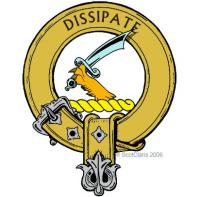
Clan Scrymgeour
The name Scrymgeour is believed to derive from the Old English word 'skrymsher' which means 'swordsman'. The Scrymgeours are probably descendants of the great MacDuff Earl of Fife and may have claimed their office as standard bearer from their early Celtic origins. It was customary for Celtic armies to be accompanied by sacred holy relics usually borne by a hereditary keeper. It is believed that the Clan Scrymgeours may have carried the pastoral staff of St Columba.
During the Wars of Scottish Independence the Clan Scrymgeour were supporters of Sir William Wallace. They were confirmed as banner bearers by Sir William Wallace in 1298. The document in which this is recorded is the only contemporary document to have survived in which the names of William Wallace and Robert the Bruce are mentioned together. At this time the chief of the clan was Alexander Scrymgeour he was later captured by the English and hanged in Newcastle in 1306 on the direct orders of King Edward I. He was succeeded by another Alexander Scrymgeour who rode as royal banner bearer when the clan fought at the Battle of Bannockburn.
In the 15th century the Clan Scrymgeour continued to prosper and the chief who was the seventh constable of Dundee acquired the lands of Dudhope in 1495. They would go on to build a castle in this land which would remain as their seat until 1668. In the 16th century the Clan Scrymgeour fought at the Battle of Flodden. As the chief was just an infant the clan was led by his nephew, John Scrymgeour. John was mortally wounded.
Sir James Scrymgeour was sent to Denmark to negotiate the marraige of King James VI to Princess Anne and in 1604 he was appointed a commissioner to negotiate a political union with England after Queen Elizabeth I of England died without heir and King James of Scotland became the King of England too. He died in 1612 and was succeeded by his son John Scrymgeour. John Scrymgeour was raised to the peerage by King Charles I as Viscount of Dudhope and Baron Scrymgeor of Inverkeithing in 1641.
During the Civil War the second Viscount of Dudhope was sent with the Scottish Covenanter forces to assist the Parliament of England against Charles I. He led the Clan Scrymgeour at the Battle of Marston Moor in July 1644, where he received a fatal wound. He was succeeded by his son, also called John. This John Scrymgeour supported the Royalist cause and commanded a cavalry regiment from the clan, under the Duke of Hamilton in 1648. He also fought at the Battle of Worcester in 1651. He escaped after the royal defeat and joined the army of General Middleton in the Scottish Highlands. He was eventually captured in 1654.
At the restoration of the crown in 1660 he was rewarded with the title Earl of Dundee. He died in 1668 without issue and all of his castles, lands, estates and royal office were seized by the Duke of Lauderdale upon a legal pretext. Lauderdale sent soldiers to carry off all of the Clan Scrymgeour charters and papers from Dudhope Castle. He then declared that there were no lawful heirs and the esates were reverted to the crown. Lauderdale then had all of the estates given to his brother by the crown. The estates should have gone to a John Scrymgeour of Kirkton who was the great-grandson of the fifth Constable of Dundee.
The grandson of the rightful John Scrymgeour of Kirkton, David Scrymgeour of Birkhill, Sherriff of Inverness married Cathrine, daughter of Sir Alexander Wedderburn of Blackness. Their son succeeded in 1788 as heir of the line of David Wedderburn of Wedderburn. Therefore the Scrymgeours gained that family's title and estates. The Scrymgeour family continued to assert their rights to their ancient titles which were taken from them. At the coronation of King Edward VII, Henry Srymgeour-Wedderburn carried the standard of Scotland
Henry Scrymgeours grandson succeeded in a case before the House of Lords gaining back the Scrymgeour's Dundee estates and gaining the title of 11th Earl of Dundee. In 1954 he was also created by the peer of the United Kingdom as Baron Glassary to enable him to take up Government office and became Deputy Leader of the House of Lords. The current chief of Clan Scrymgeour is Alexander Henry Scrymgeour of Dundee, the 12th Earl of Dundee has followed his father into politics in the House of Lords.
The Scrymgeour family seat is still at Birkhill north of Cupar in Fife.





